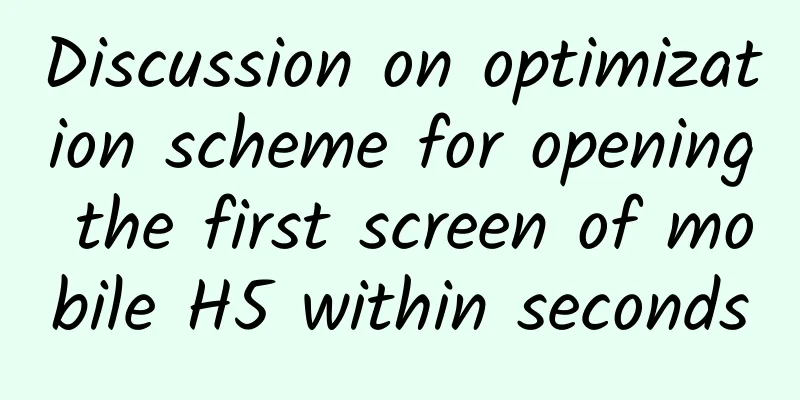Discussion on optimization scheme for opening the first screen of mobile H5 within seconds

|
As the performance of mobile devices continues to improve, the performance experience of web pages has gradually become acceptable. Due to the many advantages of the web development model (cross-platform, dynamic update, reduced size, and instant expansion), more and more embedded web pages appear in APP clients (in order to match the current popular saying, all web pages are referred to as H5 pages below, although they may have nothing to do with H5). Many APPs have changed some functional modules to use H5. Although the performance of H5 pages has improved, the experience is still very bad if no targeted optimization is done. There are mainly two parts of the experience:
This article will not discuss the second point, but only the first point, how to reduce the white screen time. For some functional modules in the APP that use H5, how to speed up their startup speed and make their startup experience close to the native one.
process Why does a long white screen appear when you open an H5 page? Because it does a lot of things, probably:
Front-end optimization There are many optimization points in the process of opening a page, including the front-end and the client. Conventional front-end and back-end performance optimization has been widely practiced in the desktop era. The main ones are:
The biggest factor affecting the first screen startup speed is the network request, so the focus of optimization is cache. Here we will focus on the front-end cache strategy for requests. Let's break it down into HTML cache, JS/CSS/image resource cache, and json data cache. HTML and JS/CSS/image resources are all static files. HTTP itself provides caching protocols. Browsers implement these protocols and can cache static files. For details, please refer to here. In general, there are two types of cache:
The most extreme cache strategy that the front-end can do is: HTML files ask the server every time if there is an update, and JS/CSS/Image resource files do not request updates, and directly use local cache. How to update JS/CSS resource files? The common practice is to give each resource file a version number or hash value during the build process. If the resource file is updated, the version number and hash value change, the URL of the resource request will change, and the corresponding HTML page will be updated to request a new resource URL, and the resource will be updated. The cache of json data can use localStorage to cache the requested data. When displaying ***, you can use local data first and then request an update. This is all controlled by the front-end JS. These cache strategies can achieve full caching of resource files such as JS/CSS and user data, and can use local cache data directly every time without waiting for network requests. However, this cannot be done for HTML file caching. For HTML files, if the Expires/max-age time is set too long, only the local cache is used for a long time, and the update is not timely. If it is set too short, each time the page is opened, a network request must be sent to ask if there is an update, and then determine whether to use local resources. Generally, the front-end strategy here is to request every time, which will still cause the user to feel a long white screen time in a weak network. Therefore, there is a contradiction between "caching" and "updating" of HTML files. Client optimization Then it is the client's turn. In the desktop era, H5 pages could not be optimized more due to the limitations of browsers. Now H5 pages are embedded in client apps, and clients have more permissions, so clients can go beyond the scope of browsers and do more optimization. HTML Cache Let's talk about cache first. The client has a more flexible cache strategy. The client can intercept all requests for H5 pages and manage the cache by itself. For the contradiction between "caching" and "updating" of the above HTML files, we can use the following strategy to solve it:
This seems to be more advanced. The HTML file is cached using the client's strategy, and the rest of the resources and data follow the front-end caching method mentioned above. In this way, when an H5 page is accessed for the second time, everything from HTML to JS/CSS/Image resources and then to data can be read directly from the local computer without waiting for network requests. At the same time, it can be updated as quickly as possible, solving the caching problem and greatly improving the startup speed of the first screen of the H5 page. question The above solution seems to have completely solved the cache problem, but there are still many problems:
These problems can be solved on the client side, but it is a bit troublesome. Here is a brief description:
The above solution is very cumbersome to implement because there are many HTML and resource files and they are scattered and difficult to manage. There is a better solution to these problems, which is the offline package. Offline package Since many problems are caused by the difficulty of decentralized file management, and our usage scenario here is to use H5 to develop functional modules, it is easy to think of packaging and distributing all the relevant pages and resources of each functional module. This compressed package can be called the offline package of the functional module. Using the offline package solution can solve the above problems relatively easily:
At this point, offline packages are a good solution for developing functional modules using H5. Let me briefly repeat the offline package solution:
More optimizations The offline package solution has done a good job in caching, and some details can be optimized: Public resource package Each package will use the same JS framework and CSS global style. It is too wasteful to duplicate these resources in each offline package. You can create a public resource package to provide these global files. Preload webview Whether it is iOS or Android, it takes a lot of time to initialize the local webview. You can initialize the webview in advance. There are two types of preloading:
Preloading Data Ideally, when the offline package is opened for the first time, all HTML/JS/CSS are cached locally without waiting for network requests. However, user data on the page still needs to be pulled in real time. An optimization can be made here to request data in parallel while the webview is initialized. It takes some time for the webview to be initialized, and there are no network requests during this period. Parallel requests at this time can save a lot of time. In terms of specific implementation, you can first indicate in the configuration table the URL that needs to be preloaded for a certain offline package. The client initiates a request while the webview is initialized. The request is managed by a manager. When the request is completed, the result is cached. Then, after the webview is initialized, it starts to request the URL that has just been preloaded. The client intercepts the request and transfers it to the request manager mentioned above. If the preloading is completed, the content is returned directly. If not, it waits. Fallback What should be done if a user accesses an offline package module but the offline package has not been downloaded, or the configuration table detects that a new version is available but the local version is an old version? Several solutions:
The above solutions and strategies can also be used together, depending on business needs. Using the Client Interface If the network and storage interfaces use webkit's ajax and localStorage, there will be many limitations and it will be difficult to optimize. These interfaces can be provided to JS on the client side. The client can make more detailed optimizations on network requests, such as DNS pre-resolution/IP direct connection/long connection/parallel request, etc. Storage can also use client interfaces to perform targeted optimizations such as read-write concurrency/user isolation, etc. Server-side rendering In early web pages, JS was only responsible for interaction, and all content was directly in HTML. In modern H5 pages, many contents have relied on JS logic to decide what to render. For example, waiting for JS to request JSON data, then splicing it into HTML to generate DOM and rendering it on the page, so the rendering and display of the page has to wait for this entire process, which is time-consuming. Reducing this time consumption is also within the scope of white screen optimization. The optimization method can be to reduce the JS rendering logic artificially, or it can be more thorough, returning to the original state, where all content is determined by the HTML returned by the server, without waiting for the JS logic, which is called server-side rendering. Whether to do this optimization depends on the business situation. After all, this will bring negative effects such as changes in development mode/increased traffic/increased server-side overhead. Some pages of mobile QQ use server-side rendering, which is called dynamic direct output, see the article. *** From front-end optimization, to client caching, to offline packages, to more detailed optimizations, by achieving the above points, the H5 page startup experience can be almost comparable to the native experience. In summary, the general optimization ideas are: cache/preload/parallel, cache all network requests, try to load all content before the user opens it, and do things in parallel instead of serially. Some of the optimization methods here require a complete set of tools and process support, which needs to be weighed against development efficiency and optimized according to actual needs. In addition, the above discussion is about the optimization solution for opening H5 pages in seconds for functional modules. In addition to functional modules on client APP, some other H5 pages such as marketing activities/external access may not be applicable to some optimization points. It depends on the actual situation and needs. In addition, WeChat applet belongs to the category of functional modules, which is almost the same routine. Here we discuss the optimization of the H5 page first screen startup time. After the above optimization, basically the only time-consuming issue is the startup/rendering mechanism of the webview itself. This issue, together with the subsequent response smoothness issue, belongs to another optimization scope, which is a solution like RN/Weex. We will discuss it again when there is a chance. |
<<: Implementing HttpServer on Android
>>: Qualcomm: Android phone users will be able to use face recognition next year
Recommend
Why can’t you write a good copy that scores 80 points?
I have read "Copywriting Fever", "...
Beibei emotional video play, a mobile phone, no need to appear on camera, play the video plan
Beibei Emotional Chinese Video Game, a mobile phon...
The fission gameplay of Weibo traffic diversion!
I have been in the Internet circle for 6 years an...
Here is a complete online community event planning plan
The work of operations is to perform a series of ...
6 tips to improve ROI of information flow advertising!
Everyone is familiar with information flow advert...
LG officially announces its exit from smartphone business
LG said in a regulatory filing that its mobile co...
Civil Code Practice Essentials Course - Property Rights and Contracts Special Lectures Value 599 Yuan - Baidu Cloud Download
This set of courses comes from Zhiqia - Civil Cod...
Several cases of brands making a fortune on Kuaishou
Recently, it seems that more and more brands have...
Analysis of Taobao and Douyin’s live e-commerce competitors
This article focuses on Douyin e-commerce, analyz...
How to promote on Bilibili?
Bilibili , a video content community that started...
Analysis of advertising video materials!
In recent years, with the increasing demand of th...
How can Douyin become popular? How does Douyin become popular?
After we have improved our Tik Tok account and ha...
Behind Kuaishou’s entry into cities, how to promote in the rural market?
The rural market gives you a long time, and you h...
Jinan Electrician Mini Program production price inquiry, how much does it cost to produce Jinan Electrician Mini Program?
There is no fixed price for the production of Jin...
The past, present and future of private domain traffic!
one The concept of private domain traffic should ...









